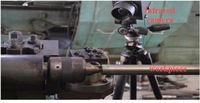In an innovative research effort, scientists have developed a new approach to enhance the machining of Inconel 825, a nickel-based superalloy known for its high strength and thermal resistance. This study establishes an integrated method combining experimental techniques with finite element analysis (FEA), offering a novel framework for improving the turning process when using tungsten carbide tools.
One of the significant challenges with Inconel 825, commonly used in aerospace and chemical industries, is its propensity for tool wear and the heat generated during machining. The study leverages infrared thermal imaging alongside numerical simulations to monitor transient temperature profiles and cutting forces under various machining conditions. By utilizing an L9 orthogonal array for experimental design, researchers meticulously explored the impacts of feed rate, cutting speed, and depth of cut.
The research showcases the innovative capacity of infrared thermal imaging technology, which allows exact monitoring of tool interface temperatures—providing irreplaceable data that enhance traditional machining methods. By integrating this real-time monitoring with FEA simulations executed in Abaqus, the researchers employed an elastoplastic material model that accurately captures the workpiece’s material behavior under thermal stress.
Results from the study indicate that increasing cutting speed leads to a reduction in cutting forces, while temperature gradients revealed complex interactions that vary non-linearly. Importantly, the findings confirm a robust relationship between experimental results and numerical predictions; discrepancies in cutting force measurements remained within a mere 5% margin. This high correlation underscores the effectiveness of the proposed methodology in optimizing machining processes.
In a controlled experimental setup, the turning operations utilized Inconel 825 as the workpiece material, which measured 100 mm in length and 30 mm in diameter. The trials were conducted at a range of speeds, reaching up to 1500 revolutions per minute. The infrared thermal imaging camera (InfraTec VarioCAM hr head 400) effectively captured real-time temperatures across the cutting interface, operating within a temperature range of -40 to 2000 °C.
To elaborate further on the findings, it was revealed that interface temperatures tended to rise alongside increases in cutting speed, whereas cutting pressures diminished at lower speeds. A key takeaway from the experimental data was the effect of feed rates: deeper cuts exhibited higher chip and tool-chip interface temperatures due to increased friction and wear. Additionally, reducing the rake angle of the cutting insert was shown to effectively lower both chip and tool-chip interface temperatures, which in turn lowered cutting forces.
Moreover, the study utilized Minitab software to construct a multiple regression model aimed at predicting cutting forces based on the independent variables of feed rate, cutting speed, and depth of cut. This model serves as a valuable predictive tool for future machining applications of Inconel alloys, aiding in the refinement of machining protocols.
Overall, the research strongly suggests that employing coated tungsten carbide tools results in reduced interface temperatures and improved cutting stability. This further signifies the impact of advanced tool materials in enhancing the manufacturing capabilities for challenging materials like Inconel 825. While the findings provide a solid foundation for optimizing machining processes, researchers emphasize the necessity for more studies to advance understanding of discrepancies in temperature readings and tool wear mechanisms.
This forward-thinking research not only contributes valuable insights into the machining of superalloys but also establishes a comprehensive framework that can guide future investigations and practical applications in industrial settings. With the increasing demand for precision machining in high-performance sectors, the integration of innovative analytical techniques marks a promising advancement in the field.

